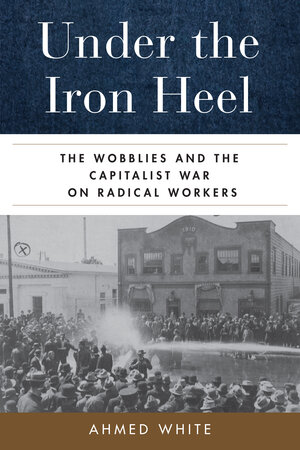By Ahmed White, author of Under the Iron Heel: The Wobblies and the Capitalist War on Radical Workers
In the late 1910s and early 1920s, the Industrial Workers of the World was the target of the most intensive campaign of state-sponsored repression in American history. A story of violence, law, and class conflict in the waning years of the progressive era, what happened to the union is a lesson about the place of labor radicalism in liberal society that’s still relevant today. It’s a story relevant to imagining what will become of the unexpected surge of labor activism over the last few years.
The IWW was founded in 1905 with the purpose of organizing the industrial working class and leading a massive general strike that would demolish the “wage-labor” system and pave the way for a workers’ commonwealth. For years, the union flirted with irrelevance. However, by the time the United States entered the First World War, it claimed over 100,000 members, had organized several times that number, and had become a potent force, especially among migratory workers west of the Mississippi River. This did not bring the IWW near its goal of revolution, but it did threaten the interests and values of powerful capitalists and their allies in government who had set out to destroy the union.
Between 1917 and 1925, some 500 “Wobblies,” as the union’s members were called, were imprisoned on charges of violating the Espionage Act by conspiring to undermine the war effort or committing “criminal syndicalism” by advocating violent, revolutionary change. These convictions were easily gotten, as these laws —designed to break the IWW— made membership tantamount to guilt. During this period, thousands of Wobblies were also prosecuted for vagrancy and similar crimes by a process that likewise treated IWW membership as proof of culpability.
Driven by contrived depictions of the Wobblies as violent and seditious, this campaign to crush the IWW went beyond legal repression, featuring widespread, sometimes deadly vigilantism as well as the occasional framing of union members for serious crimes. Part of the “Red Scare,” the persecution of the IWW and its members extended well past the point at which that chapter in American history ostensibly ended, lasting as long as the IWW remained viable.
The Wobblies’ response to this campaign is a study in resilience and courage, as the union soldiered on and its members endured extraordinary acts of cruelty and deprivation with great bravery and determination. In the spirit of solidarity and defiance, many volunteered to be prosecuted or disdained early release from prison. But this story also reveals the limits of what the union and its members could endure, as the IWW wilted under financial and organizational strains, new recruits were deterred, and even the staunchest Wobblies were worn down, demoralized, and sometimes shattered by their experiences. By 1925, the union had been driven into irrelevance, in large part as a consequence of all this persecution.
Ironically, the Wobblies had essentially predicted this. From the outset, they were sure they would be viciously persecuted and that, in proof of capitalist domination of the state and its legal system, principles like due process, equal protection, and freedom of speech and association would hardly impede this. Their prophecies were confirmed, not only on street corners and in jails, prisons, and legislatures, but also in the courts, where almost everything done to these radicals was deemed rightly deserved.
Although sponsored in part by conservatives and reactionaries, this was also the work of progressives. Well represented among the legislators, police, and prosecutors who persecuted the IWW, progressives were likewise prominent among the judges who oversaw and upheld the conviction of the union’s members. In fact, few episodes in American history so clearly demonstrate progressivism’s intolerance for those who seem to threaten its vision of an orderly society that is tempered by reform but adherent to the institutions and values of private property and capitalism.
A century later, this story has an enduring relevance as critics and commentators reckon with the fate of an American labor movement that, after decades of crisis and decline, has shown real signs of life. Motivated by historic levels of economic inequality, pervasive insecurity, and widespread resentment of oligarchical rule, workers are making earnest attempts to organize powerful, antiunion firms, challenging sclerotic leaders in their own ranks, and undertaking strikes at a rate not seen in decades. This upwelling in activism, which most recently culminated in a nationwide railroad dispute that was settled by the intervention of a Democratic President and Congress and the largest strike of academic workers in United States History at the University of California, has resurrected questions that arise every time labor surges: How far might this wave of activism go? And what might happen if it does begin to seem like something radical?
Of course, history is not destiny. Much has changed since the Wobblies were crushed “under the iron heel,” as they put it. And those behind the current surge in labor activism don’t much resemble the Wobblies in their demands and aspirations, at least not yet. But it is hard not to see these bygone radicals’ encounters with repression as a sobering reminder of how effectively powerful people, abetted by the state and its legal system, can crush threats to their interests and values. And it is just as hard not to see in these encounters something of a warning about the likely limits of today’s liberals’ tolerance for a resurgent labor movement, should it seem to demand too much.

